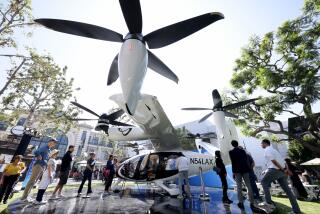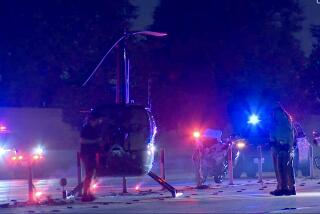Lights! Cameras! Copters!
A camera-toting miniature helicopter darts out from under a railroad trestle over the Los Angeles River and trains the lens on Beverly Free. The television commercial producer sees a bird’s-eye view of herself on a video monitor--and is impressed.
Remote-controlled helicopters can fly where humans wouldn’t dare, and that means business for both Coptervision of Van Nuys and Flying-Cam Inc. of Santa Monica. The two companies have cornered a small part of a $100-million-plus industry that supplies aerial footage for film and TV directors who want fresh, edgy shots. That’s what Free had in mind when she watched a Coptervision demonstration during pre-production work on national spots for a chain of fitness centers.
Free, in Los Angeles on behalf of Pitlik Studio of Minneapolis, says she wants a shot of a health club that starts out high in the air, then zooms down for a close-up of people splashing in the pool and then pulls back up into the sky.
“We’ll have to look at our budget, but this looks like what we need,” says Free as she peers into the monitor.
Coptervision and Flying-Cam are occupying booths not far apart in the Los Angeles Convention Center through Sunday at Variety’s Showbiz Expo, an entertainment production industry trade show where Hollywood’s latest toys are trotted out.
The tiny helicopters are a small niche of an important Hollywood industry, says Peter McKernan Jr., president of Motion Picture Aviation Inc. He estimates that worldwide billings for helicopters for feature film, TV and commercial production exceed $100 million annually, including equipment rentals, crew salaries and insurance. Helicopters are essential for filming many action sequences--think “ConAir”--so big-budget action productions have been paying upward of $3 million apiece for footage shot from choppers, said McKernan, whose father, Peter McKernan Sr., has piloted camera choppers for TV and movies for 20 years.
“And eight out of 10 car commercials use helicopters,” adds McKernan Jr.
Much of the business is cornered by a dozen major players, most based in Southern California, which have organized the Motion Picture Pilots Assn., McKernan says. Members of the trade group rely on scores of freelancers and ancillary companies.
Demand for their services is global, says Dwayne McClintock, an engineer with SpaceCam Systems Inc. of Westlake Village, which rents out specialized gyro-stabilizing gear for cameras mounted on manned copters. The equipment assures vibration-free images, such as those generated during televised broadcasts of high-speed freeway chases. Cameras in such a rigging can also make shots while suspended from cables strung between 100-foot-tall cranes or while being rapidly lowered from high-rise buildings.
But Hollywood’s miniature choppers--which have been deployed in recent weeks in New Mexico, Thailand and the European Alps--can capture aerial shots impossible to get any other way.
Daniela Spiwak, vice president of Coptervision, cued up a demo reel offering a hummingbird’s-eye view of the Egyptian Theater in Hollywood. The camera sails lazily between a row of palm trees in the courtyard, then wheels past the vintage movie palace’s Pharaonic leitmotifs and then soars aloft, taking in an over-the-rooftop panorama of Tinseltown.
There is true artistry in getting such a shot, says Emanuel Previnaire, president of 11-year-old Flying-Cam. “Finding a good ‘pilot’ is like finding someone who can play the violin.”
Using remote controls, one crew member maneuvers the aircraft while another operates the camera. The two must work in close coordination.
Previnaire, who has been a director and cinematographer of short films, won a 1995 Motion Picture Academy certificate of technical contribution for developing a proprietary remote-control miniature helicopter. He also built his own 35mm camera system--dubbed Birdy-Cam--that carries a 200-foot film magazine, allowing a bit more than two minutes of shooting.
Flying-Cam charges $10,000 a day for a crew and a helicopter. The company, which has a European office near Brussels, has a fleet of helicopters. Two-year-old Coptervision, which has rates starting at about $8,500 a day, uses modified model helicopter kits with proprietary controls using Arri 35mm film cameras in gyro-stabilizing housings.
The copters, which can reach speeds of nearly 50 mph, can take off and hover in a large room, Coptervision employees said. Coptervision adapts commercially available kits while Flying-Cam builds its own proprietary craft.
Both Spiwak and Previnaire say their choppers, which rarely fly above 300 feet, have had to make a few emergency landings but have never crashed or caused injury. Their safety rules include keeping spectators at a distance during takeoffs and landings and making sure their pilots don’t keep the choppers hovering over people. Paul Turk, a spokesman for the Federal Aviation Administration, says the agency does not regulate or certify the small copters.
Coptervision President Sarita Spiwak--Daniela’s mother--says her firm has followed a plan drafted by partner and Chief of Operations Carlos Hoyos. Hoyos, a native of Colombia, was working as a camera operator for the entertainment-news show “Camera Viajera” when he got the idea for a remote-controlled copter-cam.
In many instances, the remote-control helicopters can save time and money for a quick shot. Renting a full-size helicopter can require purchasing $5 million in liability insurance, obtaining FAA clearance for flights and hiring a fire safety officer when taking off and landing away from airports--which is often the case in film work, says Donna Washington, vice president of operations at the L.A. Film Office. None of that is required for the small helicopters.
Coptervision’s fleet of four working copters--two more are about to go on line--also can work close to a subject without stirring up dust and rippling the water the way a full-sized copter does. They’re also brought in to work in tunnels and inside buildings, “situations where you wouldn’t want to put a pilot at risk,” says Daniela Spiwak.
Producer Jacquelyn Ruffner of Sherman Oaks recently employed a mini-copter for a soaring close-up of a jet taxiing for takeoff. “We had to make sure that we didn’t get sucked into the engine intake.”
Even Robin Petgrave, president of Bravo Helicopters and Wing in Torrance, which has a fleet of choppers including the familiar 7-passenger Astars that appear in scores of action movies, admits that the miniature copters have advantages over his equipment.
“You can take off from your driveway and go 300 feet in the air, or you can follow somebody up to the front door of a building and then fly up to the 10th floor and right into the window,” says Petgrave. “Of course it would have to be a pretty big window.”
More to Read
The biggest entertainment stories
Get our big stories about Hollywood, film, television, music, arts, culture and more right in your inbox as soon as they publish.
You may occasionally receive promotional content from the Los Angeles Times.










